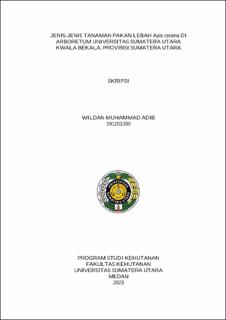| dc.description.abstract | Indonesia has very high and abundant natural resource potential. The resources contained therein are very diverse, especially from forest products, both in the form of timber forest products and non-timber forest products (NTFPs). Honey bees are one of the sources of Indonesia's biodiversity. Apart from that, Indonesia's conditions offer great potential for the development of beekeeping businesses. This research aims to identify the diversity of plant types and find out flowering schedule of plants that produce nectar and pollen as a source of food for bees honey (Apis cerana) at the USU Kwala Bekala Arboretum, Deli Serdang Regency, North Sumatra Province. The method used in this research is the observation method with a radius of 800 meters and the library method, where the stages of this research consist of data collection, namely using primary data, secondary data and data analysis. The results of this research obtained 45 types of plants Apis cerana bee food with a total of 13,444 individual plants that have the potential to be a food source for Apis cerana bees, of which there are 15 types of agricultural plants, 25 types of forestry plants, and 5 types of ornamental plants/wild grasses. These plants are flowering plants that have varying flowering seasons, some flower seasonally and some flower all year round. There are 33 types of plants that flower seasonally and 12 types of plants that flower throughout the year. The diversity of bee food plants in the Kwala Bekala University of North Sumatra Arboretum strongly supports the plan to cultivate honey bees. | en_US |


